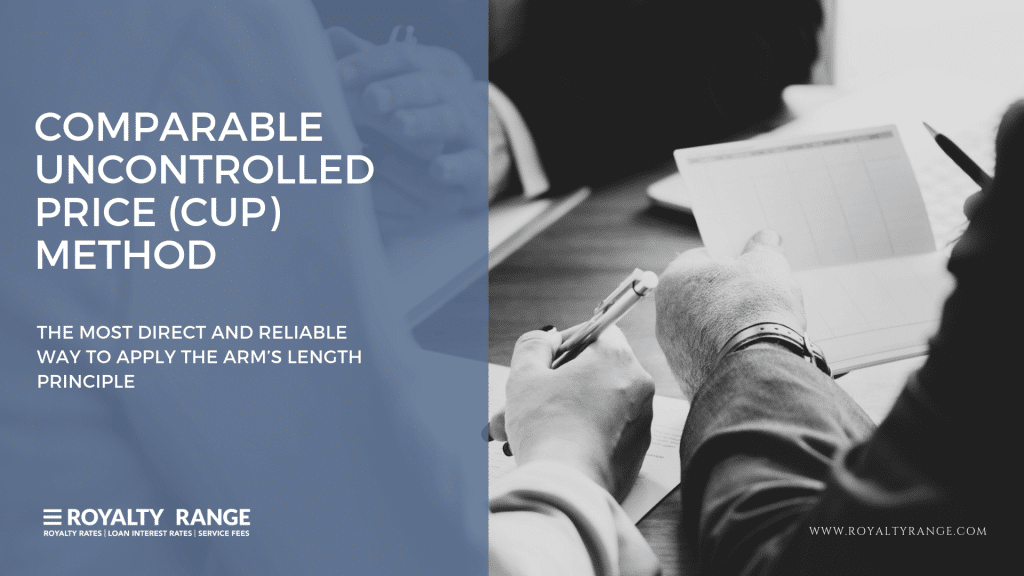Transfer pricing – comparable uncontrolled price (CUP) method

Kris (Kestutis) Rudzika |
January 14, 2019

In our previous article about transfer pricing methods, we explained that there are five main methods to choose from: 1) the comparable uncontrolled price (CUP) method; 2) the cost plus method; 3) the resale price method; 4) the transactional net margin method (TNMM); and 5) the transactional profit split method. In this article, we focus on the CUP method to provide you with a full understanding of what it is, and when and how it should be used.
Before you learn about the CUP method, you need to know what transfer pricing (TP) and the arm’s length principle are. If you need guidance on these concepts, or just want to refresh your memory, you may find it useful to start with our What is Transfer Pricing? blog.
Key definitions for the CUP method
There are lots of terms that you need to be familiar with to understand the various transfer pricing methods. We have defined some terms you’ll need to know for the CUP method below (you’ll find more definitions in our blog post, Transfer Pricing Terminology Explained).
- Controlled transaction: A transaction that takes place between associated enterprises (or related entities/parties).
- Uncontrolled transaction: A transaction that takes place between independent enterprises (or unrelated entities/parties).
- Associated enterprises (AEs): Two or more enterprises that participate, directly or indirectly, in the management, control or capital of the other(s). You can find a more in-depth definition in Article 9 of the Organisation for Economic Co-operation and Development (OECD)’s 2014 Model Tax Convention.
- Independent enterprises (IEs): Two or more enterprises that are not associated enterprises with respect to the above definition and the Model Tax Convention.
- Traditional transaction method: A transfer pricing method that compares the conditions of an uncontrolled transaction with those of a controlled transaction, either through price or less direct measures, such as gross margins on transactions.
- Internal comparables: Comparables data gained from looking at an uncontrolled transaction that took place between the organization in the controlled transaction and an unrelated third party.
- External comparables: Comparables data gained from looking at an uncontrolled transaction that took place between two independent enterprises.
- Commodities: Physical products for which a quoted price is used as a reference by independent parties in the industry to set prices in uncontrolled transactions.
- Quoted price: The price of a commodity in the relevant period obtained in an international or domestic commodity exchange market.
Choosing a transfer pricing method
The ultimate aim of using transfer pricing (TP) methods is to identify whether the conditions of your organization’s commercial or financial relations with associated enterprises (AEs) comply with the arm’s length principle (ALP), meaning they are the same as those of independent enterprises (IEs) in comparable circumstances.
As per the OECD’s guidance, you should always try to find the most appropriate transfer pricing method for your particular scenario. You should opt for the method that will produce the most accurate results, rather than the one that is easiest or most convenient.
Here are some things to take into account when choosing a transfer pricing method:
- The strengths and weaknesses of the method (see the end of this article for these)
- The appropriateness of the method for your controlled transaction (you can conduct a functional analysis to determine this – see our blog, What is A Functional Analysis?)
- The availability of reliable comparables (you can access these through our database)
What is the CUP method?
The CUP method is a traditional transaction method. Traditional transaction methods are considered the most direct way of determining whether prices and conditions between associated enterprises are at arm’s length. In fact, the OECD states that, where reliable comparables data is available, “the CUP method is preferable over all other methods.”
The OECD’s definition of the CUP method
The OECD’s 2017 Transfer Pricing Guidelines for Multinational Enterprises and Tax Administrations define the CUP method as: “A transfer pricing method that compares the price for property or services transferred in a controlled transaction to the price charged for property or services transferred in a comparable uncontrolled transaction in comparable circumstances.” They call it “the most direct and reliable way to apply the arm’s length principle,” provided there are reliable comparable uncontrolled transactions available.

When should I use the CUP method?
You should use the CUP method if you have access to reliable comparables data for uncontrolled transactions (you can use the RoyaltyRange database to find this information on comparable royalty rates, service fees or loan interest rates).
The CUP method is particularly appropriate for commodity transactions where the same products are sold in the controlled and uncontrolled transactions. The product needs to be of a similar type, quality and quantity within both transactions, and the transactions need to happen at roughly the same time, under similar conditions, and at the same stage in the production or distribution chain. It can also be used for transactions where there are slight differences in the product, as long as the differences do not have a material effect on the price. If they do materially affect the price, and you can’t make adjustments to eliminate this material effect, then you’ll need to use a different method.
The OECD gives the following example. Say the controlled transaction involves unbranded Colombian coffee beans. If you can find an uncontrolled transaction where an independent enterprise sells unbranded Colombian coffee beans of a similar type, quality and quantity as the coffee beans in the controlled transaction – and the transactions took place at roughly the same time, at the same stage in the production/distribution chain, and under similar conditions – then the uncontrolled transaction is suitably comparable. If you can only find an uncontrolled transaction involving Brazilian coffee beans, then you would need to determine whether this difference in origin has a material effect on the price. After all, the country of origin could affect the quality of the coffee beans, meaning that they are priced at a premium on the open market or, on the other hand, discounted on the market.
The CUP method is also popular for organizations who want to set arm’s length interest payments for intercompany loans or conduct transactions involving royalty payments. You can use our loan interest rates database and our royalty rates database for such projects.
How does the CUP method work?
To use the CUP method, you need to identify a comparable uncontrolled transaction that took place under comparable circumstances to the controlled transaction you’re assessing. You can find the comparables data you need for your analysis in the RoyaltyRange database.
You can either use internal comparables or external comparables. Internal comparables are transactions that have taken place between your organization and an independent party (as opposed to the controlled transaction that is taking place between your organization and an associated enterprise). External comparables are transactions that have taken place between independent enterprises in comparable conditions to the controlled transaction.
With the CUP method, you’ll compare the price and conditions of the controlled transaction between associated enterprises with the price and conditions of the comparable uncontrolled transaction between independent enterprises that you’ve located. If the two prices are the same, the conditions of the controlled transaction are at arm’s length. If the two prices are different, the conditions of your organization’s commercial or financial relations with the associated enterprise may be not at arm’s length. You would need to substitute the price in the controlled transaction with that of the comparable uncontrolled transaction to help you see what the conditions need to look like to be at arm’s length.
Example of how the CUP method works
In the below example, we show how and why an organization chooses the CUP method as the most appropriate transfer pricing method, and how they apply it for their analysis.
A UK manufacturing company, Blast, manufactures the Rapid Dry Xtreme – a high-power, professional-standard chemical solution that is up to five times more effective in certain condition than other solutions on the market. There is only one other UK manufacturer that produces a solution with similar performance to the Rapid Dry Xtreme – manufacturing company Chem Tech Solutions, with its Supersonic XL chemical solution. Both Blast and Chem Tech Solutions operate in a similar way when it comes to manufacturing, pricing and selling their products, with both companies selling via associated and third-party distributors.
Blast receives an order for one shipment of Rapid Dry Xtreme from its distribution company, All Things Chemical, which is an associated enterprise of Blast.
In order for Blast to apply an accurate transfer price for the transaction, it needs to first choose a transfer pricing method. As Chem Tech Solutions, its competitor, has a similar product and operates in a similar way, it will potentially be possible to access reliable data for comparable uncontrolled transactions, so Blast opts for the CUP method. While other methods may also work, the OECD recommends the CUP method above all others if you have access to data on comparable uncontrolled transactions.
When it comes to finding the price of a comparable transaction using the CUP method, Blast has two options: 1) it can refer to the price at which it sells the Rapid Dry Xtreme product to unrelated third-party distributors (known as an ‘internal comparable’); or 2) it can refer to the price at which a competitor sells the Supersonic XL product to unrelated third-party distributors (so the price at which the product is sold between two unrelated parties, known as an ‘external comparable’). Both options are acceptable under the CUP method, although it is preferable to use internal comparables as these generally provide substantial evidence that your pricing is at arm’s length. In addition, both products are branded products, and although they may have similar properties, they may target different markets and price points, and thus may be not comparable.
If Blast’s pricing for the sale of a Rapid Dry Xtreme to its associated enterprise distributor, All Things Chemical, is the same as the pricing seen in the comparable uncontrolled transaction, then Blast’s pricing can be said to be at arm’s length. If the two prices are different, then the commercial and financial relations between Blast and All Things Chemical may be not at arm’s length, and transfer pricing adjustments may be required.
If the two prices are different, Blast will need to substitute the controlled price with the uncontrolled price (as in, base the analysis on the price given in the comparable uncontrolled transaction), so that it can see what the commercial and financial relations between itself and All Things Chemical need to look like to achieve arm’s length.
How do I know if an uncontrolled transaction is comparable?
You can work out if an uncontrolled transaction is comparable by asking yourself two questions:
- Are there any differences between the transactions I’m comparing or the parties entering into those transactions that could materially affect the price? You should take into account differences in:
- Products or services
- Contractual terms
- Economic circumstances
- Business strategies
- If there are differences between the transactions, can you make reasonable adjustments to eliminate their effect on the price charged in the open market?
If there are no differences, or the differences can be reasonably adjusted to eliminate any effect on price, then the uncontrolled transaction is comparable. If there are differences and reasonable adjustments cannot be made, then the transaction may not be comparable.
If you cannot find a comparable uncontrolled transaction, you will need to consider another method. You may consider one of the methods below.
- Cost plus method
- Resale price method
- Transactional net margin method (TNMM)
- Transactional profit split method
Advantages and disadvantages of the CUP method
As with all the transfer pricing methods, there are strengths and weaknesses of the CUP method that you should take into account before applying it. None of the methods are perfect in all circumstances, so you need to approach your selection on a case-by-case basis.
The advantages of the CUP method are:
- It’s the most direct way of finding arm’s length conditions, as it uses the market price. Plus, it’s the OECD’s preferred choice for any analysis where comparables data is available.
- It’s ideal for commodity transactions, as these are often highly comparable and it’s relatively easy to find reliable comparables data.
- It allows for flexibility. If you need to combine it with another transfer pricing method, you can – as long as you’ve made sure that these methods are appropriate.
- It provides you with a lot of evidence to present to tax authorities, as it directly shows that your transaction is aligned with market conditions. This enables you to manage and minimize risks to your transfer pricing and taxes.
- You can use a database like RoyaltyRange to find the comparables data you need.
The disadvantages of the CUP method are:
- It can be difficult to find comparable uncontrolled transactions that meet the strict comparability criteria of the CUP method (even a small difference in the product or conditions can have a material effect on price). Saying this, adjustments can be made to eliminate the effect on price, and the difficulties you encounter when making them should not stop you from using the method if it’s the most appropriate option.
- Making adjustments can reduce the reliability and accuracy of your analysis using the CUP method. This depends on the extent and reliability of your adjustments.
Where can I get comparables data for the CUP method?
In order for you to use the CUP method accurately, you need to be able to identify reliable comparable uncontrolled transactions. Using RoyaltyRange’s databases is the quickest, easiest and most reliable way of finding comparables data for your transfer pricing analysis. Our data is fully compliant with the OECD’s guidelines and is assessed against more than 50 comparability factors, enabling you to find relevant, up-to-date agreements to help you conduct a strong, accurate analysis and determine arm’s length pricing for your transaction.
Join the thousands of taxpayers using our databases to make their transfer pricing analyses easier. Get your free trial today.
You can use this text with reference to RoyaltyRange website.
Request One Search
We will perform the search and deliver the initial results within hours, at no cost.




